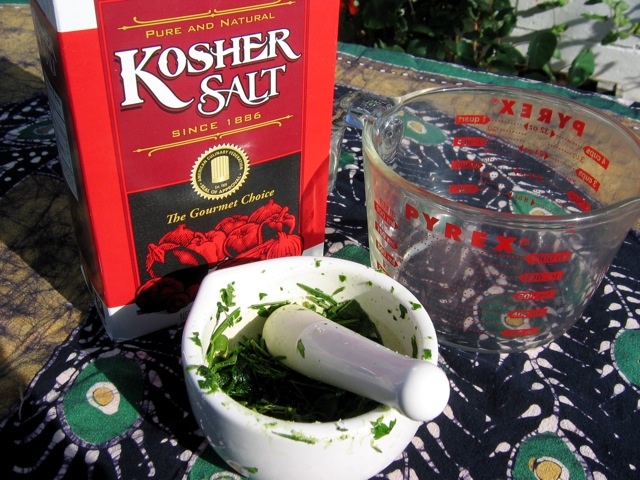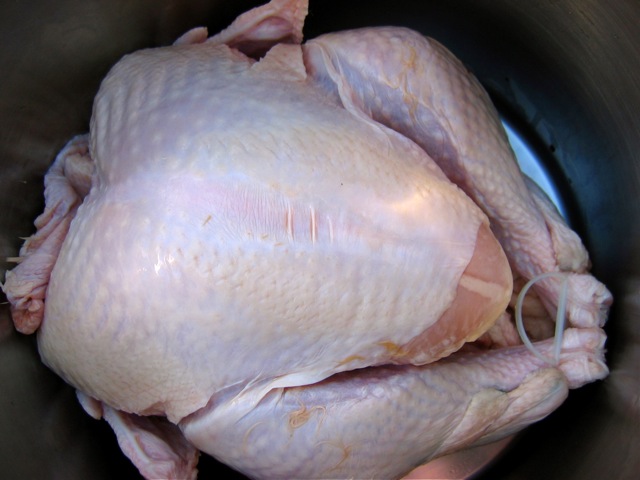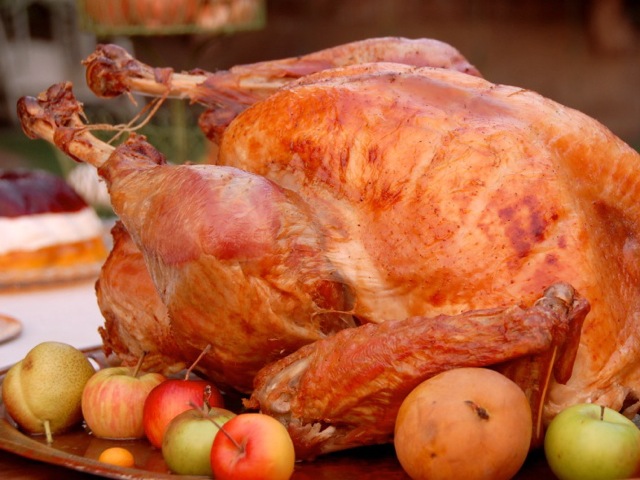
saltherbs, l
(article, Caroline Cummins)
[%pageBreakSettings nobreak=true] Whether your turkey this Thanksgiving season is small (8 pounds) or enormous (20 pounds), there are plenty of ways to take it from raw to succulent. Gearheads, you have plenty of options, ranging from the deep fryer to the smoky grill to the [%amazonProductLink "infrared cooker" asin=B000W74HI2]. And if Jeffrey Steingarten (in It Must've Been Something I Ate) could have his druthers, we'd all be cooking our birds the medieval way, turned slowly and cooked evenly on a spit. But most of us will stick to ye olde kitchen oven, propping the bird on a rack in a roasting pan and cooking it for a few hours till done. [[block(sidebar). h1.Featured recipesFor a complete Thanksgiving menu, see "Classic Thanksgiving." ]] Confronted with the heavy duty of roasting an entire bird to feed a crowd, newbie turkey chefs often dig out lots of cookbooks and magazines, trying to suss out the best roasting recipe. But of course, no two publications ever offer the same roasting advice. The Joy of Cooking and The New Basics Cookbook, for example, will tell you to roast at 325 degrees. Mark Bittman's How to Cook Everything (Completely Revised 10th Anniversary Edition), on the other hand, likes to roast at 350 degrees, while Cook's Illustrated magazine wants you to roast that baby at 400 degrees. Bittman, along with such magazines as Gourmet and Food & Wine, likes to pour water or stock into the roasting pan, beneath the V-rack holding up the bird, to produce steam and make sure the bird stays moist. Some authorities suggest lining the rack with foil; others suggest using that foil to tent the top of the bird instead. Some tell you to rub the bird with butter, some say to skip the butter and just baste as you go, and some endorse buttering and_ basting. Some want you to flip the bird partway through, to ensure the breast meat doesn't get overcooked; others rely on the foil tent to keep the bird from drying out. That whole dry-bird thing gets people in a dither every year. Basting? Tenting? Brining beforehand? Mitchell Davis, in Kitchen Sense, dismisses brining as a fad, saying that so long as you don't cook your bird too long, dryness shouldn't be a problem: bq. Everyone is so paranoid about salmonella and other bacteria and food-borne illnesses associated with poultry that we overcook all of our birds just to be safe. The truth is that these bacteria are killed at 160 degrees, so as long as you cook your meat to that temperature, and you clean your work area and utensils after handling raw poultry to avoid cross-contamination, you shouldn't have anything to worry about. The other food-safety worry at Thanksgiving, of course, comes up over stuffing, which if left unattended and warm (instead of hot or cold) for too long can become a bacterial festival. Bake your stuffing in a casserole dish instead of inside the bird and just use extra stock if you like your stuffing moist. If you insist on an authentically stuffed bird, though, just remember that the bird will finish cooking before the stuffing does, so you'll probably need to scoop the stuffing out (use a big silicone glove to protect your hand from the hot insides of the bird) and finish baking it separately. Gravy fans should also keep in mind the fact that stuffing inside a bird will soak up the meaty juices that usually drip into the roasting pan — a problem if you like to make your gravy with pan drippings while the cooked bird is resting and cooling before getting carved. Solve this problem (and avoid last-minute stovetop stress) by making your gravy ahead of time and simply reheating it when you're ready to serve the turkey. And for those of you who attend the Church of Brining — because it sure makes for a tender, tasty bird — here's a quick photo essay on turkey-brining basics. For proportions and specific instructions, see the recipe for Brined and Roasted Turkey. [%image turkeyinpot float=center width=500 caption="If you have a small turkey, you can brine it in a large stockpot. Otherwise, thoroughly clean a cooler (you know, the kind you use for camping) and brine the bird in it; bleach out the cooler afterwards."] [%image saltherbs float=center width=500 caption="Salt is a must in brining; fresh herbs are optional."] [%image saltpot float=center width=500 caption="Cover the bird with water, then add salt."] [%image herbspot float=center width=500 caption="Add herbs, then use your hands to turn the bird over several times and distribute the herbs and dissolve the salt."] [%image butterbird float=center width=500 caption="Rinse the bird off when the brining is done and pat it dry; let it air-dry, uncovered, in the fridge if you want a crispier skin. Then rub butter all over the bird, making sure to get under the skin."] [%image reference-image float=center width=500 caption="The finished product."] p(bio). Caroline Cummins is Culinate's managing editor.

saltherbs, l

saltpot, l

herbspot, l

butterbird, l

turkeyinpot, l

reference-image, l